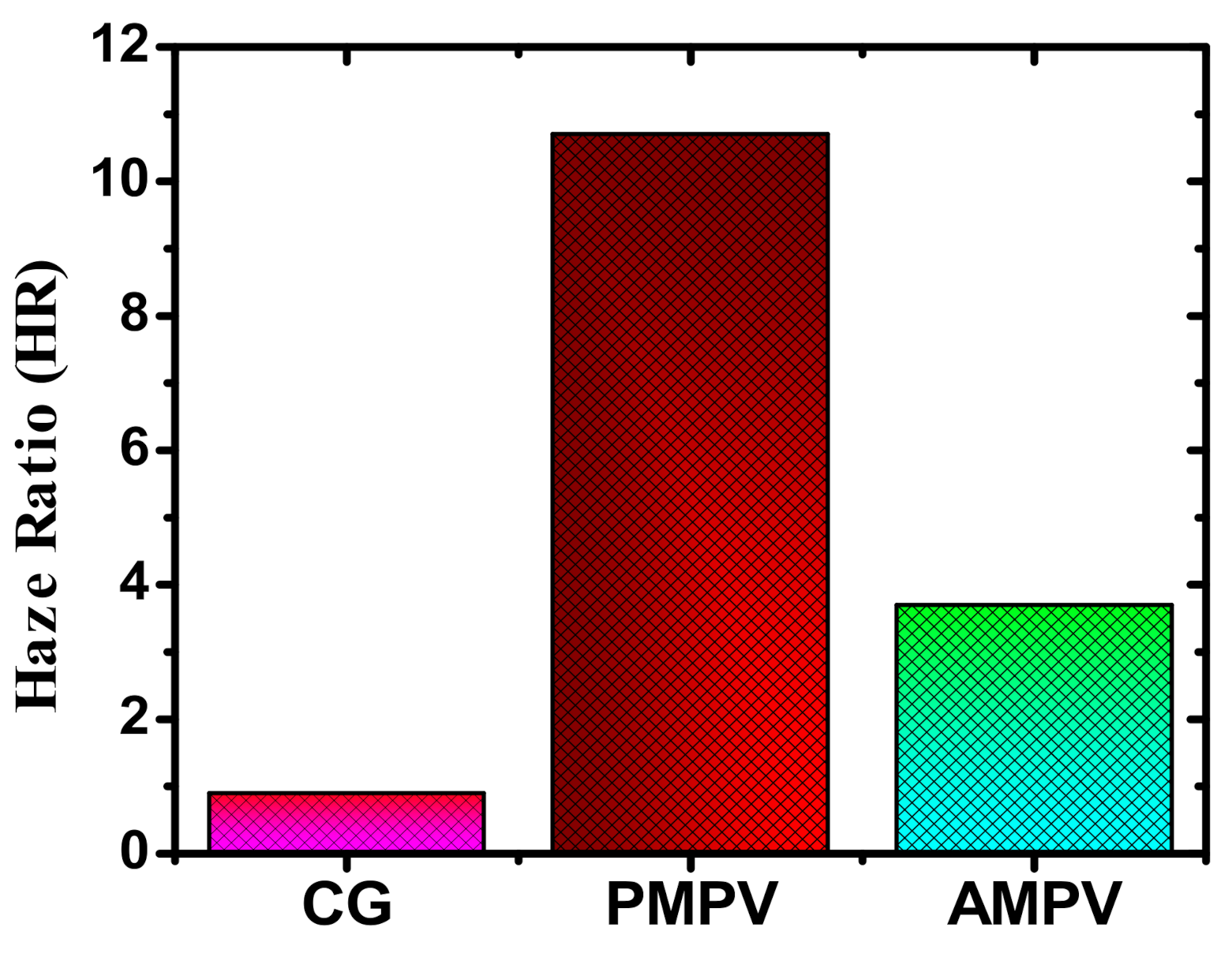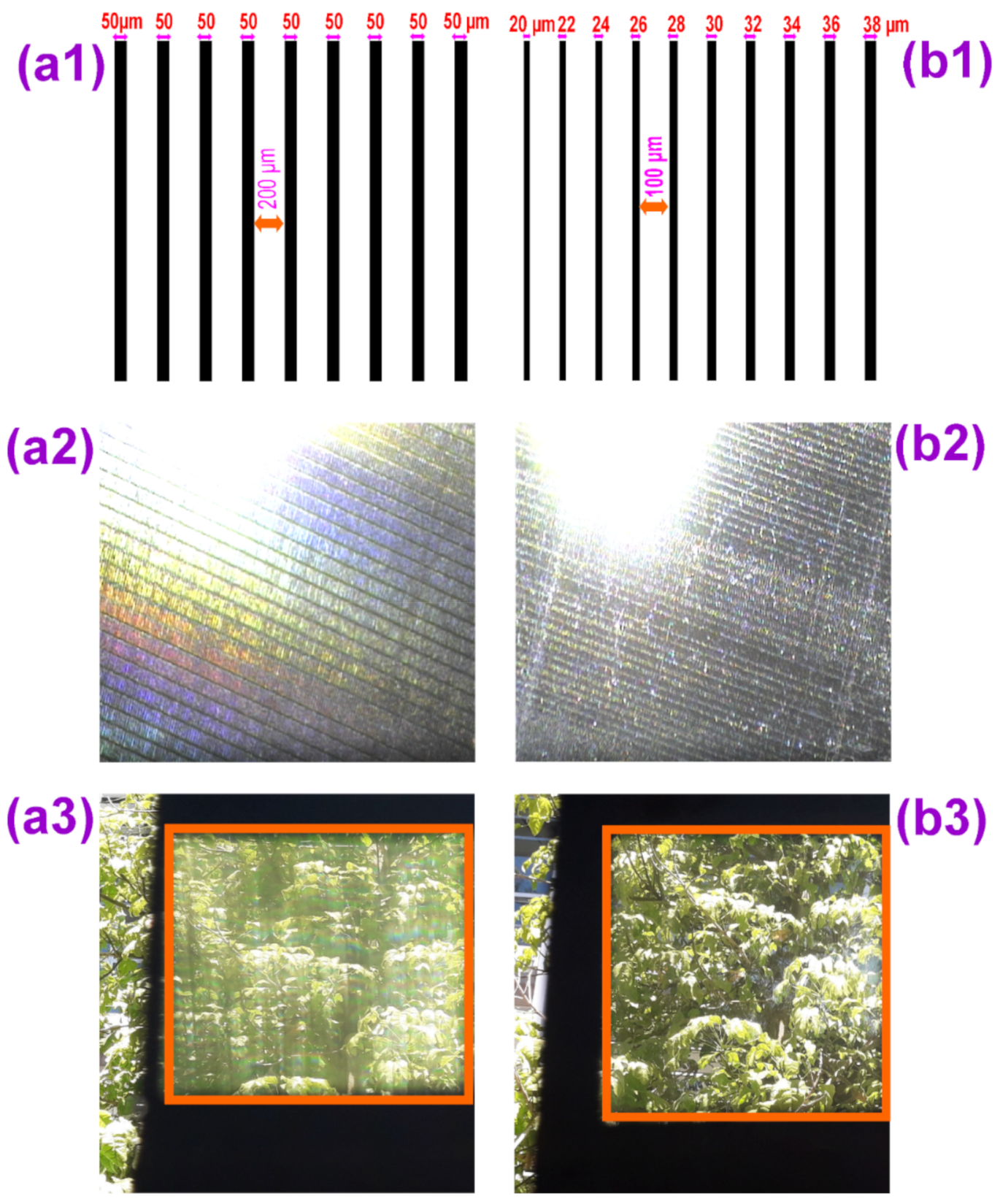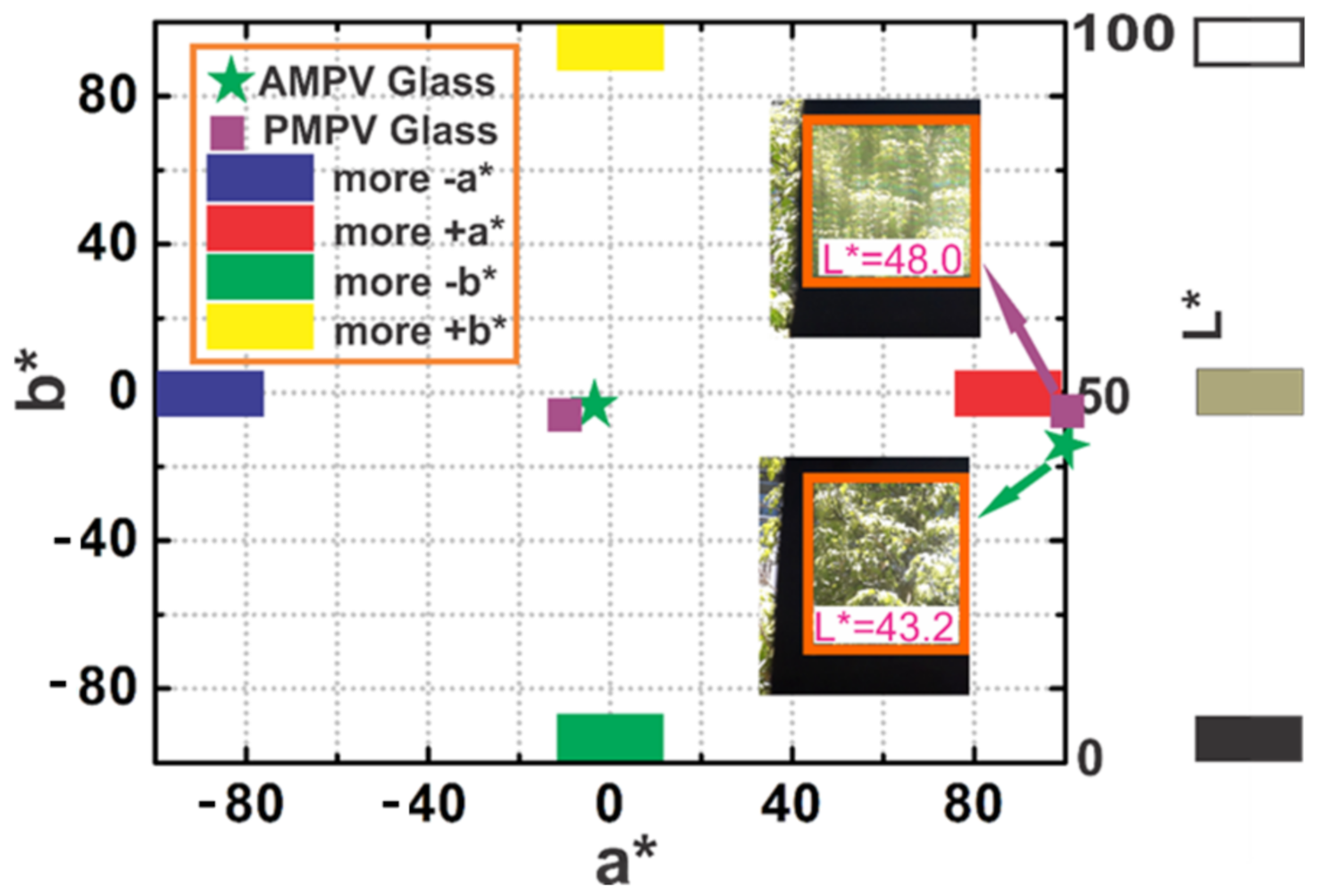Design, Development, and Characterization of Low Distortion Advanced Semitransparent Photovoltaic Glass for Buildings Applications
Abstract
:1. Introduction
2. Materials and Methods
3. Results and Discussion
4. Conclusions
Author Contributions
Funding
Institutional Review Board Statement
Informed Consent Statement
Data Availability Statement
Acknowledgments
Conflicts of Interest
Abbreviations
| Advanced Solar Power | ASP |
| Aperiodic micropattern-based photovoltaic | AMPV |
| Average visible transmittance | AVT |
| Building integrated photovoltaic | BIPV |
| Cadmium telluride | CdTe |
| Clear glass | CG |
| International Commission on Illumination | CIE |
| International organization of standardization | ISO |
| Micrometers | Mm |
| Net-zero energy building | NZEB |
| Nitrogen oxides | NOx |
| Periodic-micropattern-based photovoltaic | PMPV |
| Photovoltaic | PV |
| Semitransparent photovoltaic | STPV |
| Sulfur dioxide | SO2 |
| Tera joule | TJ |
| Transparent photovoltaic | TPV |
References
- Tripathy, M.; Sadhu, P.K.; Panda, S. A critical review on building integrated photovoltaic products and their applications. Renew. Sustain. Energy Rev. 2016, 61, 451–465. [Google Scholar] [CrossRef]
- Vasiliev, M.; Alameh, K. Recent developments in solar energy-harvesting technologies for building integration and distributed energy generation. Energies 2019, 12, 1080. [Google Scholar] [CrossRef] [Green Version]
- Attia, S. Net Zero Energy Buildings (NZEB): Concepts, Frameworks and Roadmap for Project Analysis and Implementation; Elsevier: San Diego, CA, USA, 2018. [Google Scholar]
- Owusu, P.A.; Asumadu-Sarkodie, S. A review of renewable energy sources, sustainability issues and climate change mitigation. Cogent Eng. 2016, 3. [Google Scholar] [CrossRef]
- Asumadu-Sarkodie, S.; Owusu, P.A. Feasibility of biomass heating system in Middle East Technical University, Northern Cyprus Campus. Cogent Eng. 2016, 3. [Google Scholar] [CrossRef]
- Edenhofer, O.; Madruga, R.P.; Sokona, Y.; Seyboth, K.; Matschoss, P.; Kadner, S.; Zwickel, T.; Eickemeier, P.; Hansen, G.; Schlömer, S.; et al. Renewable Energy Sources and Climate Change Mitigation; Cambridge University Press: Cambridge, UK, 2011; ISBN 9781139151153. [Google Scholar]
- Kumar, N.M.; Sudhakar, K.; Samykano, M. Performance comparison of BAPV and BIPV systems with c-Si, CIS and CdTe photovoltaic technologies under tropical weather conditions. Case Stud. Therm. Eng. 2019, 13, 100374. [Google Scholar] [CrossRef]
- Snow, M.; Prasad, D. Designing with Solar Power: A Source Book for Building Integrated Photovoltaics (BIPV); Routledge: London, UK, 2005; pp. 1–128. [Google Scholar]
- Eder, G.; Peharz, G.; Trattnig, R.; Bonomo, P.; Saretta, E.; Frontini, F.; Polo López, C.S.; Rose Wilson, H.; Eisenlohr, J.; Martin Chivelet, N.; et al. Coloured BIPV-Market, Research and Development; International Energy Agency: Paris, France, 2019; p. 60. [Google Scholar]
- Jelle, B.P. Building integrated photovoltaics: A concise description of the current state of the art and possible research pathways. Energies 2015, 9, 21. [Google Scholar] [CrossRef] [Green Version]
- EUR-Lex. Document 02010L0031-20181224. Available online: https://eur-lex.europa.eu/eli/dir/2010/31/2018-12-24 (accessed on 13 April 2020).
- Wong, P.; Shimoda, Y.; Nonaka, M.; Inoue, M.; Mizuno, M. Semi-transparent PV: Thermal performance, power generation, daylight modelling and energy saving potential in a residential application. Renew. Energy 2008, 33, 1024–1036. [Google Scholar] [CrossRef]
- Peng, J.; Curcija, D.C.; Lu, L.; Selkowitz, S.E.; Yang, H.; Zhang, W. Numerical investigation of the energy saving potential of a semi-transparent photovoltaic double-skin facade in a cool-summer Mediterranean climate. Appl. Energy 2016, 165, 345–356. [Google Scholar] [CrossRef]
- Bayoumi, M. Impacts of window opening grade on improving the energy efficiency of a façade in hot climates. Build. Environ. 2017, 119, 31–43. [Google Scholar] [CrossRef]
- Ballif, C.; Perret-Aebi, L.-E.; Lufkin, S.; Rey, E. Integrated thinking for photovoltaics in buildings. Nat. Energy 2018, 3, 438–442. [Google Scholar] [CrossRef]
- Cohen, J.J.; Reichl, J.; Schmidthaler, M. Re-focussing research efforts on the public acceptance of energy infrastructure: A critical review. Energy 2014, 76, 4–9. [Google Scholar] [CrossRef]
- Mittag, M.; Kutter, C.; Ebert, M.; Wilson, H.R.; Eitner, U. Power loss through decorative elements in the front glazing of BIPV modules. In Proceedings of the 33rd European PV Solar Energy Conference and Exhibition, Amsterdam, The Netherlands, 25–29 September 2017. [Google Scholar]
- Probst, M.M.; Roecker, C. Criteria for architectural integration of active solar systems IEA task 41, subtask A. Energy Procedia 2012, 30, 1195–1204. [Google Scholar] [CrossRef] [Green Version]
- Tabakovic, M.; Fechner, H.; van Sark, W.; Louwen, A.; Georghiou, G.; Makrides, G.; Loucaidou, E.; Ioannidou, M.; Weiss, I.; Arancon, S.; et al. Status and outlook for building integrated photovoltaics (BIPV) in relation to educational needs in the BIPV Sector. Energy Procedia 2017, 111, 993–999. [Google Scholar] [CrossRef]
- Goh, K.C.; Goh, H.H.; Yap, A.B.K.; Masrom, A.N.; Mohamed, S. Barriers and drivers of Malaysian BIPV application: Perspective of developers. Procedia Eng. 2017, 180, 1585–1595. [Google Scholar] [CrossRef]
- Yang, R.J.; Zou, P. Building integrated photovoltaics (BIPV): Costs, benefits, risks, barriers and improvement strategy. Int. J. Constr. Manag. 2016, 16, 39–53. [Google Scholar] [CrossRef]
- Karakaya, E.; Sriwannawit, P. Barriers to the adoption of photovoltaic systems: The state of the art. Renew. Sustain. Energy Rev. 2015, 49, 60–66. [Google Scholar] [CrossRef] [Green Version]
- Yang, R.J. Overcoming technical barriers and risks in the application of building integrated photovoltaics (BIPV): Hardware and software strategies. Autom. Constr. 2015, 51, 92–102. [Google Scholar] [CrossRef]
- Azadian, F.; Radzi, M.A.M. A general approach toward building integrated photovoltaic systems and its implementation barriers: A review. Renew. Sustain. Energy Rev. 2013, 22, 527–538. [Google Scholar] [CrossRef]
- Taleb, H.; Pitts, A. The potential to exploit use of building-integrated photovoltaics in countries of the Gulf Cooperation Council. Renew. Energy 2009, 34, 1092–1099. [Google Scholar] [CrossRef]
- Prieto, A.; Knaack, U.; Auer, T.; Klein, T. Solar façades—Main barriers for widespread façade integration of solar technologies. J. Facade Des. Eng. 2017, 5, 51–62. [Google Scholar] [CrossRef]
- Scognamiglio, A.; Privato, C. Starting points for a new cultural vision of BIPV. In Proceedings of the 23rd European Photovoltaic Solar Energy Conference and Exhibition, Valencia, Spain, 1–5 September 2008; pp. 3222–3233. [Google Scholar]
- Lee, K.-T.; Lee, J.Y.; Seo, S.; Guo, L.J. Colored ultrathin hybrid photovoltaics with high quantum efficiency. Light Sci. Appl. 2014, 3, e215. [Google Scholar] [CrossRef]
- Lien, S.-Y. Artist photovoltaic modules. Energies 2016, 9, 551. [Google Scholar] [CrossRef] [Green Version]
- Attoye, D.E.; Aoul, K.A.T.; Hassan, A. A review on building integrated photovoltaic façade customization potentials. Sustainability 2017, 9, 2287. [Google Scholar] [CrossRef] [Green Version]
- Peharz, G.; Berger, K.; Kubicek, B.; Aichinger, M.; Grobbauer, M.; Gratzer, J.; Nemitz, W.; Großschädl, B.; Auer, C.; Prietl, C.; et al. Application of plasmonic coloring for making building integrated PV modules comprising of green solar cells. Renew. Energy 2017, 109, 542–550. [Google Scholar] [CrossRef]
- Soman, A.; Antony, A. Colored solar cells with spectrally selective photonic crystal reflectors for application in building integrated photovoltaics. Sol. Energy 2019, 181, 1–8. [Google Scholar] [CrossRef]
- Calyxo. CDTE Thin Film Solar Module CX1; Calyxo: Bitterfeld-Wolfen, Germany, 2011. [Google Scholar]
- The Ultimate Guide to Vector Software. CorelDRAW. Available online: https://www.coreldraw.com/en/tips/vector-images/vector-software/ (accessed on 21 June 2021).
- How Do Lasers Work—Basics. Available online: https://www.troteclaser.com/en/faqs/how-does-a-laser-work/ (accessed on 10 September 2020).
- Working Principle of Laser Marking Machine. Available online: https://www.xtlaser.com/for-new-user-working-principle-of-fiber-laser-marking-machine-max-from-xt-laser/ (accessed on 10 September 2020).
- Laser Engraving Glass. Available online: https://www.engraversjournal.com/legacyarticles/2360/ (accessed on 10 September 2020).
- Hwang, I.; Choi, D.; Lee, S.; Seo, J.H.; Kim, K.-H.; Yoon, I.; Seo, K. Enhancement of light absorption in photovoltaic devices using textured polydimethylsiloxane stickers. ACS Appl. Mater. Interfaces 2017, 9, 21276–21282. [Google Scholar] [CrossRef]
- Lee, K.; Um, H.-D.; Choi, D.; Park, J.; Kim, N.; Kim, H.; Seo, K. The development of transparent photovoltaics. Cell Rep. Phys. Sci. 2020, 1, 100143. [Google Scholar] [CrossRef]
- Lee, K.; Kim, N.; Kim, K.; Um, H.-D.; Jin, W.; Choi, D.; Park, J.; Park, K.J.; Lee, S.; Seo, K. Neutral-colored transparent crystalline silicon photovoltaics. Joule 2020, 4, 235–246. [Google Scholar] [CrossRef]
- Gratings Separate the Different Colors of Light—Laser Focus World. Available online: https://www.laserfocusworld.com/optics/article/16550914/gratings-separate-the-different-colors-of-light (accessed on 10 September 2020).
- Chen, K.-S.; Salinas, J.-F.; Yip, H.-L.; Huo, L.; Hou, J.; Jen, A.K.-Y. Semi-transparent polymer solar cells with 6% PCE, 25% average visible transmittance and a color rendering index close to 100 for power generating window applications. Energy Environ. Sci. 2012, 5, 9551–9557. [Google Scholar] [CrossRef]
- Traverse, C.J.; Pandey, R.; Barr, M.C.; Lunt, R.R. Emergence of highly transparent photovoltaics for distributed applications. Nat. Energy 2017, 2, 849–860. [Google Scholar] [CrossRef]
- Lunt, R.R. Theoretical limits for visibly transparent photovoltaics. Appl. Phys. Lett. 2012, 101, 043902. [Google Scholar] [CrossRef]
- Colonna, D.; Capogna, V.; Lembo, A.; Brown, T.M.; Reale, A.; Di Carlo, A. Efficient cosensitization strategy for dye-sensitized solar cells. Appl. Phys. Express 2012, 5, 022303. [Google Scholar] [CrossRef]
- Saifullah, M.; Gwak, J.; Yun, J.H. Comprehensive review on material requirements, present status, and future prospects for building-integrated semitransparent photovoltaics (BISTPV). J. Mater. Chem. A 2016, 4, 8512–8540. [Google Scholar] [CrossRef]
- Yang, C.; Liu, D.; Bates, M.; Barr, M.C.; Lunt, R.R. How to accurately report transparent solar cells. Joule 2019, 3, 1803–1809. [Google Scholar] [CrossRef]
- Fisette, P. Windows: Understanding Energy Efficient Performance. 2003. Available online: https://bct.eco.umass.edu/publications/articles/windows-understanding-energy-efficient-performance/ (accessed on 10 September 2020).
- CIELAB Color Space—Wikipedia. Available online: https://en.wikipedia.org/wiki/CIELAB_color_space (accessed on 10 September 2020).
- Myong, S.Y.; Jeon, S.W. Design of esthetic color for thin-film silicon semi-transparent photovoltaic modules. Sol. Energy Mater. Sol. Cells 2015, 143, 442–449. [Google Scholar] [CrossRef]
- Tang, Y.; Cai, W.; Xu, B. Profiles of phenolics, carotenoids and antioxidative capacities of thermal processed white, yellow, orange and purple sweet potatoes grown in Guilin, China. Food Sci. Hum. Wellness 2015, 4, 123–132. [Google Scholar] [CrossRef] [Green Version]
- Colsmann, A.; Puetz, A.; Bauer, A.; Hanisch, J.; Ahlswede, E.; Lemmer, U. Efficient semi-transparent organic solar cells with good transparency color perception and rendering properties. Adv. Energy Mater. 2011, 1, 599–603. [Google Scholar] [CrossRef]







| Sample Name | Haze Ratio |
|---|---|
| Clear Glass (CG) | 0.9% |
| Periodic Micropaterned based PV (PMPV) glass | 10.7% |
| Aperiodic Micropaterned based PV (AMPV) glass | 3.7% |
Publisher’s Note: MDPI stays neutral with regard to jurisdictional claims in published maps and institutional affiliations. |
© 2021 by the authors. Licensee MDPI, Basel, Switzerland. This article is an open access article distributed under the terms and conditions of the Creative Commons Attribution (CC BY) license (https://creativecommons.org/licenses/by/4.0/).
Share and Cite
Basher, M.K.; Alam, M.N.-E.; Alameh, K. Design, Development, and Characterization of Low Distortion Advanced Semitransparent Photovoltaic Glass for Buildings Applications. Energies 2021, 14, 3929. https://doi.org/10.3390/en14133929
Basher MK, Alam MN-E, Alameh K. Design, Development, and Characterization of Low Distortion Advanced Semitransparent Photovoltaic Glass for Buildings Applications. Energies. 2021; 14(13):3929. https://doi.org/10.3390/en14133929
Chicago/Turabian StyleBasher, Mohammad Khairul, Mohammad Nur-E Alam, and Kamal Alameh. 2021. "Design, Development, and Characterization of Low Distortion Advanced Semitransparent Photovoltaic Glass for Buildings Applications" Energies 14, no. 13: 3929. https://doi.org/10.3390/en14133929
APA StyleBasher, M. K., Alam, M. N.-E., & Alameh, K. (2021). Design, Development, and Characterization of Low Distortion Advanced Semitransparent Photovoltaic Glass for Buildings Applications. Energies, 14(13), 3929. https://doi.org/10.3390/en14133929







